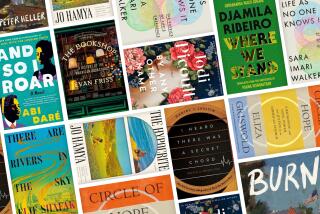Four chilling debut thrillers for your summer reading list
On The Shelf
Four Summer Thriller Debuts
The Other Black Girl
By Zakiya Dalila Harris
Simon and Shuster: 355 pages, $27
Arsenic and Adobo
By Mia P. Manansala
Berkeley: 336 pages, $16
Walking Through Needles
By Heather Levy
Polis: 320 pages, $26
People Like Them
By Samira Sedira
Translated by Lara Vergnaud
Penguin: 192 pages, $17
If you buy books linked on our site, The Times may earn a commission from Bookshop.org, whose fees support independent bookstores.
There are mystery readers who can reckon the seasons based on when their favorite authors publish another entry in a beloved series. But amid the household names piling up in TBR stacks come new voices that will make it worth reshuffling the deck. These four new and forthcoming mystery debuts deserve to be in your rotation through the height of summer.
The Other Black Girl
By Zakiya Dalila Harris
Simon & Schuster: 355 pages, $27: June 1
Leading the pack is Harrisâ perceptive exploration of racism in publishing, wrapped up in a whip-smart story of young women at war in the workplace. Nella Rogers is an ambitious, middle-class Black girl from the Connecticut suburbs whoâs toiled for two years as an editorial assistant at Wagner Books, a tony Manhattan publisher. Although itâs only an entry-level position, all of Nellaâs colleagues and superiors are white â except for the mailroom clerks and IT specialists.
Set in the 1980s, you guess? Well, there are flashbacks to 1983 when Wagner boasted the only Black editor-and-author duo in publishing, Kendra Rae Phillips and Diana Gordon. They collaborated to produce âBurning Heart,â a groundbreaking novel with a young Black female protagonist that might sound like the early work of Toni Morrison (who was also a pioneering book editor).
But no, the novelâs present action is set in 2018, a time when the percentage of Black people in publishing hovered around 5%. Wagner still publishes Gordon, to ever-declining sales, while a bestselling white Wagner author has turned in a manuscript with a stereotypical Black character that calls to mind the âAmerican Dirtâ controversy. Phillips, meanwhile, vanished without a trace not long after âBurning Heartâ came out â a mystery Nella is obsessed with unraveling.
#PublishingPaidMe shows, in part, how arbitrary book advances are. But that guesswork isnât the problem; itâs the executives doing the guessing.
Tossed into Wagnerâs current sea of whiteness is another Black girl â Hazel-May McCall, also hired as an editorial assistant. Nella hopes for a sister-friend and confidante but Hazel, with her perfectly coiffed locs, Harlem ZIP Code and tales of a grandfatherâs death in a 1960s protest, blazes past Nella to instant acceptance. Is Hazelâs more âauthenticâ Blackness the secret of her success? Or did the other Black girl stick out her foot to hasten Nellaâs fall? When Nella starts finding notes on her desk urging her to âLeave Wagner. Now,â her bestie Malaika says what Nella is loath to admit: âIf that isnât a hate crime, I donât know what is.â But microaggressions aside, who at Wagner would be that blatantly racist?
The novelâs epigraph â âBlack history is Black horror,â a quote from L.A.-based Black author Tananarive Due â suggests thereâs something more sinister afoot. What that is, and its impact on Nella, Hazel and other Black women who populate the novel, elevates âThe Other Black Girlâ to something more complicated, less âGet Outâ and more âThe Bluest Eye.â This is fitting, since Toni Morrison once said: âIf thereâs a book you really want to read, but it hasnât been written yet, then you must write it.â Harris has done exactly that and readers everywhere, including those who work in publishing, will be better for it.
Arsenic and Adobo
By Mia P. Manansala
Berkeley; 336 pages, $16
In Manansalaâs deceptively breezy debut, Lila Macapagal has left Chicago, a philandering fiancĂŠ and her undergraduate program in hospitality. She picks up the tatters of her life by helping out at her Tita Rosieâs cafe in small-town Shady Palms, two hours outside Chicago. Tita Rosieâs place is failing in part because Lilaâs high school flame, a local food blogger named Derek Winters, has been badmouthing the restaurant in an effort to shut it down. On one of his hate visits, Winters, a diabetic, is complaining about Lilaâs ube crinkle cookies made with purple sweet potato jam when she grouses, âWould it kill you to say something nice?â As if on cue, Winters convulses and falls face-first into a bowl of ginataang bilo-bilo (a coconut-rice dessert).
Iâm at the turo turo. Iâm at the grocery store. Iâm at the combination turo turo and grocery store.
Lila is arrested for his murder. Before you can say âoh my gulay,â Lila, out on bail, teams up with Adeena, her Pakistani American best friend, to sleuth and eat their way through Shady Palmsâ ethnic hot spots, all targets of Wintersâ wrath. Along the way, hunky would-be suitors emerge for Lila, while Adeena finds a girl who sparks her interest. In the process, Manansala touches on issues that matter to Filipino and other marginalized communities, including police abuses, Philippine President Rodrigo Duterteâs drug war, domestic violence and gender fluidity.
Bolstered by recipes for Lilaâs ube crinkles, Tita Rosieâs Chicken Adobo and more, Manansala, a Chicago Filipina, has reinvigorated tired tropes to create a multicultural, queer-friendly culinary mystery, making âArsenic and Adoboâ an envelope-pushing, world-expanding debut that goes down easy.
Walking Through Needles
By Heather Levy
Polis: 320 pages, $26: June 29
Now for something a little darker. Artistic but sheltered in Blanchard, Okla., in 1994, 16-year-old Samantha Mayfair fantasizes about her 15-year old stepbrother, Eric âArrowâ Walker. Arrow and his father, Isaac, swept into the small town, infiltrating the home Sam shares with her mother Jeri Anne and Grandma Haylin. As much as she yearns for the well-traveled Arrow, sheâs suspicious of Isaac â but also fascinated, especially by her stepfatherâs hands, which she sketches incessantly.
Sam and Arrow are inexorably drawn to each other, at first through their shared interest in Greek classics and later because of an attraction they canât ignore. Their furtive, charged encounters are juxtaposed with chapters narrated 15 years later by the grown-up Arrow. Eric works as an Oklahoma City handyman, slowed by a mysterious jagged scar on his calf. Cashing a check at a clientâs bank, he encounters Sam, now a bank supervisor. Ericâs extreme reaction, and the way he follows Sam home after the bank closes, suggests a darker secret.
A roundup of 2021 so far features old favorites (Mosley, Kellerman, Winspear), a couple of newer voices and settings ranging from Ghana to our own backyard.
Subsequent chapters reveal the story of the teensâ romance and Isaacâs mounting rage, which spills over into physical violence toward his son and something worse for Sam â until Isaac suddenly disappears. Fifteen years later, his body is unearthed on the farm once owned by Samâs mother and suspicion falls immediately on Eric, who had good reasons for wanting his father dead.
The ensuing police investigation unites the uneasy pair in ferreting out the truth. Equally important, Sam and Eric are forced to acknowledge what happened on that farm and determine whether they can move forward, together or separately, from the trauma inflicted on them when they were teens unable to process it all.
âWalking Through Needlesâ is a challenging but worthwhile read, a standout for its frank but sensitive exploration of trauma and desire.
People Like Them
By Samira Sedira
Translated by Lara Vergnaud
Penguin: 192 pages, $17: July 6
Inspired by a 2003 mass homicide, âPeople Like Themâ is a potent little mĂŠlange of psychological suspense and racial tension from the Algerian-born French author of three previous novels. (This is her debut in English translation.) After a freak pole-vaulting accident in high school leaves him gravely injured, Constant Guillot recovers and rebuilds a modest life for himself, his wife Anna and their two daughters as a high school coach. All is well until flashy Bakary and Sylvia Langlois arrive at a village wedding. The Parisian couple were invited at the spur of the moment but immediately draw the villagersâ attention for their handsy displays of affection and Bakaryâs face, so dark it âmelted perfectly into the night.â
âPeople Like Themâ is set in 2015, a year bookended by the January terrorist attack on Charlie Hebdo and the November mass murders throughout Paris. Removed from Franceâs urban capital and the racial conflicts underlying the attacks, Carmacâs homogeneously white villagers have little contact with the outside world, except for two regulars at the village bar, comical but bigoted old veterans of the Algerian War. They conflate âbrutishâ Bakary with the Senegalese Tirailleurs, sharpshooters in the Algerian War. As Anna notes, âweâd never had any Black people in Carmac.â
As part of our fall 2020 crime roundup, here are the top 7 entries in ongoing crime series worth losing sleep for â Connelly, Rozan, Cleeves and more.
Bakary runs his own travel company in Paris â an inconceivable feat to the old barflies â but, craving an âauthenticâ life in a French village, is building an enormous chalet on the edge of town. Bakary soon befriends Constant, charming him and other enthralled locals into investing in a banking proposition. But when Anna, bored at home and needing additional income, suggests working for the Langloises as a housecleaner, relationships subtly shift, with disastrous results.
The novelâs bucolic but unsettling portrayal of small-town jealousies and greed, class divides and incipient racism contrast sharply with courtroom scenes interspersed throughout, which can be jarring in their theatrics and gallows humor. Both could be attributed to Sediraâs background as a playwright and actress, which makes âPeople Like Themâ seem at times more like a film â lulling and then horrifying the observer in its portrayal of village life gone terribly wrong.
Woods is a book critic, editor of anthologies and author of the Detective Charlotte Justice procedurals.
More to Read
Sign up for our Book Club newsletter
Get the latest news, events and more from the Los Angeles Times Book Club, and help us get L.A. reading and talking.
You may occasionally receive promotional content from the Los Angeles Times.










